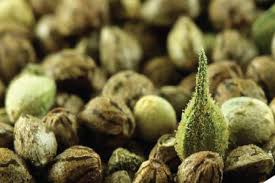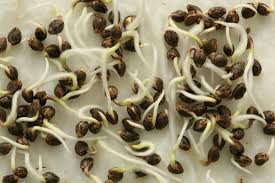Marijuana Seeds in my weed, should I try to grow them
We were searching the internet for content about marijuana seeds and we came on a couple of articles which talk about the concept of “bag seed” and what to do with those seeds. Bottom line, if you find a seed in your weed, you need to consider the following:
- Are the seeds Good or Bad
- Is the Strain one you like
- Are you prepared to Grow
- Is the seed Viable
- What about Germination
- Do you know about Cannabis seeds?
- Regular
- Feminized
- Auto-Flowering
Are the seeds Good or Bad?
Congratulations, you’ve found a seed. More specifically a bagseed, which is what marijuana seeds found in packaged flower are commonly called. Maybe congratulations aren’t quite in order. Depending on where it came from, who you ask, and if the seed is viable or not will affect your level of excitement.
 Anyone who has been smoking cannabis for some time has undoubtedly come across a bagseed. Sometimes you’ll notice a cannabis seed when grinding down some flower or you’ll see it pop, spark, and crackle as the heat of your lit bowl pops the precious kernel within.
Anyone who has been smoking cannabis for some time has undoubtedly come across a bagseed. Sometimes you’ll notice a cannabis seed when grinding down some flower or you’ll see it pop, spark, and crackle as the heat of your lit bowl pops the precious kernel within.
Bagseed: Good or Bad Weed Seeds – that is the question
If found before lighting it on fire, the first thought from excited smokers is: “Let’s grow some weed!” But before you jump in headfirst, ask yourself a few questions to help decide if it’s worth the time and energy to grow the seed.
Seeds found in finished cannabis flower can develop for a number of reasons. A nearby male plant can accidentally pollinate a flowering female. More commonly, though, they’re a sign of stress and can be attributed to high temperatures during the final stages of flowering or an exaggerated spike in climate or environment.
Seeds can also form in plants with genetic disorders or instability, like hermaphrodites—plants that develop both male and female reproductive parts. Generally these conditions are viewed as negatives, and for that reason alone, temper your expectations with any plants you start from a bagseed.
Is the Cannabis Seed You Found from Good Cannabis?
Sometimes you’ll get lucky and find a mature seed in some really nice herb. Strains like the legendary Chemdog wouldn’t be possible without adventurous smokers planting and proliferating the seeds they found in a bag of kind bud.
So don’t discount your bud just because there’s a seed or two in it. While not ideal, it could be the origins of the next great cannabis strain.
The first and most apparent question you should ask yourself is whether you enjoy the cannabis that the seed turned up in. If you don’t like the flavor, effects, or even the looks of the bud, then it’s probably not worth growing.
The second question you should ask yourself is:
Are You Ready to Grow?
Fear not! If you’re simply curious to learn how cannabis grows and less concerned with the overall outcome, you can plant a couple of bagseeds outside and see what the result are.
However, growing cannabis takes a certain level of commitment. Plants need nurturing for months in the right environment with a close eye for detail. All this takes investment. Whether it’s time, energy, or financial resources, you’ll have to commit to the whole process if you want to produce something you’re proud of.
If you’re ready for a more serious approach, make sure you have the space for a proper garden and pop the seeds to see what fruit they bear.
Is the Weed Seed Viable?
There are a few indicators that will give you a sense of whether the seed is worth germinating. Immature seeds tend to be light in color and have a soft outer shell.
 Visual signs like tiger stripes—dark stripes that resemble tiny roots or veins on a leaf—are generally good. A seed with a solid shell will withstand a little pressure when pinched between your fingers. If it crumbles or cracks, the seed will be effectively destroyed, but don’t agonize over your loss.
Visual signs like tiger stripes—dark stripes that resemble tiny roots or veins on a leaf—are generally good. A seed with a solid shell will withstand a little pressure when pinched between your fingers. If it crumbles or cracks, the seed will be effectively destroyed, but don’t agonize over your loss.
Stress on a plant and unstable environments can produce bagseeds, and often, a bagseed’s viability is questionable at best.
In some cases, even if a seed isn’t completely mature, there’s still a chance it could be viable. But often these are extremely weak, take long to develop, and express other unfavorable characteristics. Growers usually discard weak plants to free up space in their limited gardens.
You might also find a mature seed that has been physically damaged through poor handling, like rough trimming. In those cases, it probably isn’t worth the effort to try and germinate the seed.
But if the seeds you found look decent or even questionable, you might as well germinate them and see what sprouts.
Time to Germinate
Viable or not, there’s only one sure way to find out. Once you’ve decided you’re going to see what those beans can do, it’s time to germinate. Germination is the incubation period that encourages seeds to sprout and develop into a new plant.
We recommend getting the seed wet and placing into a damp paper towel. Keep the towel slightly moist and wait. Water triggers the seed to start softening the shell and letting the tap root out. Once the tap root is exposed you’re ready to put the seed into a tray and get that sprout turned into a seedling!
Even if your seed sprouts fast and grows vigorously, it has roughly a 50/50 chance of being female and producing seedless, cannabinoid-rich flowers.
Remember, once a seed germinates, the real work begins. Sexing, selecting, vegetative growth, flowering, and the eventual harvest all lie ahead.
So, let’s talk about Marijuana seeds
Cannabis seeds are considered cannabis products just like flower, edibles, and concentrates. Their legality depends on which state you live in. People living in states with adult-use legalization can buy, produce, and sell seeds within their own state, but seeds can’t cross state lines. People living in states with medical legalization can only buy seeds if they have a medical card.
Seed banks exist outside of the US and can sell them for “souvenir purposes,” but it is illegal to bring seeds into the US and Customs will seize any cannabis seeds that they find in packages or on a person.
What’s the Difference Between Regular, Feminized, and Autoflower Seeds?
- Regular Seeds
If you buy a packet of regular seeds, they’ll come with a mix of males and females. A lot of cultivators prefer to grow these because they haven’t been backcrossed—essentially inbred—as much as feminized or autoflower seeds. You’ll need to sex out the seeds once their reproductive organs show during the flowering phase and discard the males (because they don’t produce buds and will pollenate females, resulting in seeded flowers).
- Feminized Seeds
Seeds can come feminized, meaning that you can just put them in soil and start growing for buds. These seeds are guaranteed to be bud-producing females, and growing them cuts out the step of having to sex out plants and discard the males.
It also reduces the risk of having a stray male sneak into your crop—just one male can pollinate a huge crop, causing your females to focus their energies on producing seeds instead of buds.
- Autoflower Seeds
Autoflower plants change from the vegetative to flowering state with age, not the changing of their light cycle. They have a short grow-to-harvest time and can be ready to harvest in as little as 2 ½ to 3 months from when you put the seeds in the ground. The downside is that, typically, they are less potent, but autoflower seeds are great for people who want to grow cannabis but don’t want to spend a lot of time doing it.
You can learn more about Cultivation by reading our Blog Post Cannabis Cultivation Outdoors or our post Cannabis Cultivation Indoors or you can Book one of our Wine-and-Weed Tours and ask our Cultivators questions!